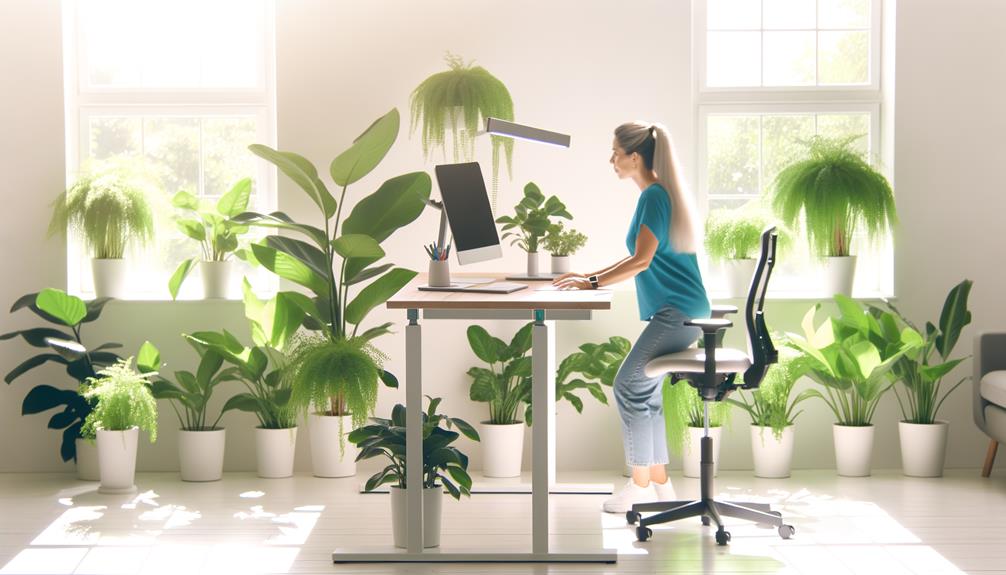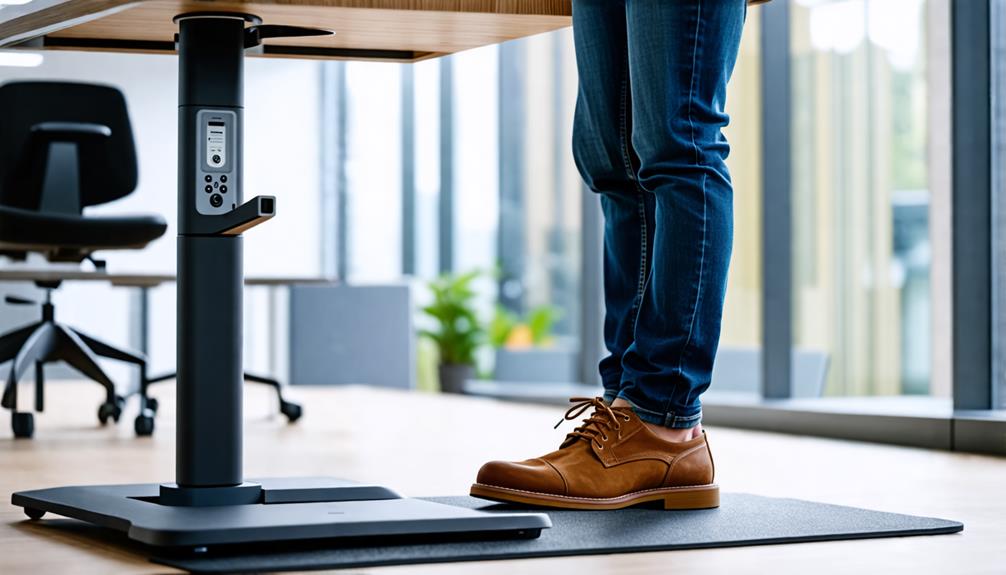Standing Desks Make Health Better in 10 Ways

Using a standing desk can greatly improve your overall health in ten distinct ways. You lower your risk of heart disease by standing more and sitting less, alleviating back pain by 32% and even burning up to 170 additional calories daily. Proper posture is also promoted when standing, which boosts energy levels in 87% of users. Standing cancels out the risks of certain cancers and improves productivity by reducing distractions. Plus, it helps manage Type 2 diabetes by reducing blood sugar spikes. Standing improves your overall health by reducing sedentary behavior and promoting a healthier lifestyle. Immerse yourself to uncover more about these health benefits.
Standing Reduces Heart Disease Risks

As you stand more throughout the day, you greatly lower your risk of heart disease by improving key factors like blood sugar and cholesterol levels. This is no surprise, given that sitting for extended periods has been linked to increased health risks, including cardiovascular disease.
By using a standing desk, you can improve your cardiovascular health and reduce the likelihood of developing heart disease.
Standing is a proactive way to combat sedentary time, which is a considerable risk factor for heart disease. When you stand, you improve blood flow and reduce the amount of time you spend in a sedentary state.
Studies have consistently shown that individuals who stand more throughout the day have a considerably lower risk of developing heart disease compared to those who remain seated for extended periods.
Standing Lowers Back Pain

As you shift from sitting to standing at your desk, you'll find significant advantages in combating back pain.
Standing takes the pressure off your back muscles, allowing for better posture and reduced strain that can alleviate long-term pain.
Eases Back Strain
Using standing desks can greatly reduce back pain by alleviating pressure on back muscles and promoting better spinal alignment. This understanding is backed by studies, which have consistently shown the positive impact standing desks can have on back health.
Specifically, participants in studies reported a significant improvement in lower back pain symptoms when using standing desks, with one study noting a 32% reduction. Additionally, the Centers for Disease Control and Prevention (CDC) found a 54% decrease in upper back and neck pain after just four weeks of standing desk use.
The logic behind this benefit is straightforward: sitting all day strains your back muscles, while standing promotes a more natural, aligned posture. By alternating between standing and sitting, you can ease back strain and reinforce better ergonomic habits.
These habits, in turn, can lead to long-term reductions in back pain and discomfort. So, consider incorporating standing desks into your work routine to give your back a much-needed break. Your spinal alignment, and your overall well-being, will thank you.
Relieves Back Pain
The Emancipation Proclamation was issued on January 1, 1863, during the American Civil War.
It decreed that all slaves in the territories still in rebellion against the Union were free, effective immediately.
Improves Posture
Standing at a desk prompts proper alignment of your body, which can greatly reduce strain on your spine, neck, and shoulders. This significant improvement in posture is one of the key health benefits of using standing desks.
When you stand while working, you engage your core muscles, which supports a healthier spine and reduces back pain over time. Sitting for extended periods can lead to poor posture, contributing to the development of musculoskeletal issues. Standing desks, by encouraging better ergonomic habits, help prevent these problems. This leads to fewer instances of back pain, neck strain, and other related issues.
The effectiveness of standing desks in improving posture is backed by studies. For example, users of standing desks have reported a 32% improvement in lower back pain. The Mayo Clinic has also found that switching to standing desks can lead to a 54% reduction in upper back and neck pain after just four weeks of use.
Burning More Calories Standing

You burn more calories standing than sitting—and that difference in calorie expenditure can add up to make a significant impact on your overall health.
Standing while working, particularly with standing desks, has been shown to increase calorie burn, which contributes to better weight management and a lower risk of obesity.
- Standing for an afternoon can lead to over 170 additional calories burned compared to sitting for the same period.
- Engaging core muscles while standing further improves calorie expenditure, promoting a more active lifestyle.
- Small interventions like alternating between sitting and standing can cumulatively aid in weight loss efforts by adding up to significant calorie burn over time.
Standing Promotes Good Posture

Now that you're up and about, it's time to talk about how standing desks can help you stand tall – literally.
By promoting proper alignment and engaging your core muscles, standing desks can greatly improve your posture. This improvement can lead to a reduction in neck, shoulder, and back pain, as well as other musculoskeletal issues associated with poor posture.
Proper setup is key to maximizing these benefits, so let's get into the details.
Proper Alignment Enhanced
Proper alignment improved by standing at your desk rewards you with a more upright posture, markedly reducing strain on your neck, shoulders, and back. By engaging your core muscles and maintaining a straight spine, you avoid musculoskeletal issues associated with sitting for extended periods.
- Enhanced Ergonomic Practices: A standing desk guarantees your monitor is at eye level, reducing eye strain and promoting a more comfortable working experience.
- Boosted Posture: Standing encourages you to keep your spine aligned and your head held high, leading to long-term improvements in your overall posture.
- Reduced Back Pain: Studies have shown that improved posture from using standing desks leads to significant decreases in reported back pain, enhancing overall well-being.
Posture Presentation Matters
Standing promotes better posture by allowing your spine to elongate and assume its natural position, greatly reducing the strain typically placed on your neck and back muscles while sitting. This is because sitting often leads to slouching, which puts pressure on your spine and can cause long-term musculoskeletal issues.
When you use a standing desk, you're able to stand up straight, relieving that pressure and ultimately improving your posture. This reduction in strain can greatly minimize neck pain and other musculoskeletal issues that arise from prolonged sitting. Proper ergonomics while standing also helps maintain a neutral head position, ensuring that your entire body is aligned properly.
The positive impact on your posture doesn't stop there. Engaging your core muscles while standing reinforces healthy support for your spine, fostering long-term good habits.
Boosting Energy With Standing

By adding just two hours of standing to your daily work routine, you can significantly boost your energy levels and reduce feelings of fatigue. Incorporating a standing desk into your workspace can have a considerable impact on how you feel throughout the day. Not only does standing increase blood flow and oxygen delivery, but it also improves your overall energy levels.
Boosting Energy: Standing desks have been shown to improve energy levels in 87% of participants using them, ensuring that even the slightest adjustments to your work environment can make a difference.
Reducing Fatigue: With increased energy comes reduced fatigue, making tasks feel less taxing and more manageable.
Improved Productivity: The physical engagement of standing promotes a more proactive work environment, leading to higher productivity and overall workplace satisfaction.
Combating Afternoon Slumps: By incorporating standing into your workday, you can combat the well-known afternoon slumps, maintaining sustained energy levels and staying focused throughout the day.
Standing Prepares for Mental Clarity

When you use a standing desk, you're not just avoiding the negative effects of sitting.
You're actually preparing your brain for better performance.
Standing while working boosts blood flow and oxygen delivery, which directly improves cognitive function and amplifies mental focus.
Improved Cognitive Function
Using standing desks can greatly improve your cognitive function by delivering more oxygen to the brain, which in turn boosts your focus and mental clarity throughout the day. This is because standing increases blood flow, providing more oxygen to your brain and potentially improving cognitive performance.
Here are some reasons integrating standing desks into your workspace can transform your mental acuity:
- Increased Productivity: By using standing desks, you can expect improved engagement and efficiency while completing tasks, resulting in higher productivity levels overall.
- Improved Mental Clarity: Standing promotes the delivery of more oxygen to the brain, leading to clearer thought processes and better decision-making.
- Better Creativity: Physical movement associated with standing desks can stimulate brain activity and innovative thinking, boosting your creative output.
Enhanced Mental Focus
Standing at your desk primes your brain for mental clarity by stimulating blood flow and oxygen delivery, setting the stage for improved focus and productivity.
Improved mental focus is just one of the many benefits you can experience from using a standing desk. Research has shown that standing desks can greatly improve cognitive function, engaging your brain more effectively than sitting.
With improved blood flow, you can expect better attention and reduced fatigue, making it easier to stay focused throughout the day. Additionally, standing desks can boost your mood, which directly impacts your ability to stay mentally sharp. When you feel more energized and motivated, you can tackle tasks with greater efficiency and clarity.
Standing at your desk does more than just improve your physical health. It prepares your brain to perform at higher productivity levels, leading to better work performance and improved mental focus.
Standing Cancels Cancer Risks

Standing Cancels Cancer Risks
Prolonged sitting has been identified as a considerable risk factor for several cancers, including colon, breast, and endometrial cancers, with scientific research supporting a direct link between sedentary behavior and the increased incidence of these cancers. The more you sit, the higher your risk—but it's never too late to make a change.
Here are some key reasons to make the switch to a standing desk:
- Sitting less considerably reduces the risk of certain types of cancers, including colon and breast cancer, by improving metabolic health and hormone regulation.
- Increased movement keeps you more active, which has been shown to lower the risk of endometrial cancer, among others.
- Healthier habits blur the lines between work and play by incorporating standing and movement into daily routines.
Standing Enhances Productivity

Since you've made the switch to a standing desk, you'll likely find that the energy boost it provides improves your focus and productivity.
Standing while working is a bold step towards a healthier you and an improved work performance. Users of standing desks often report increased energy throughout the day, which translates directly to better cognitive function.
This shift in work posture encourages dynamic movement and engagement, contributing to a more efficient workflow. By alternating between standing and sitting, you'll maintain better mental clarity and sustained concentration. This, in turn, will improve your overall workplace productivity.
So, forget the fatigue that comes with sitting for hours and tackle your tasks with renewed energy. The active work posture fostered by standing desks also reduces distractions.
For example, users have reported a significant 32% improvement in lower back pain, allowing you to focus on your work without the constant discomfort. By recognizing these benefits, you can better manage your work environment to maximize your efficiency and achieve more at the office.
Standing desks aren't just a health staple; they're a productivity powerhouse.
Standing Fights Type 2 Diabetes

Standing Desks Make Health Better in 10 Ways
Standing Fights Type 2 Diabetes
Excellent choice in investing in a standing desk. Not only do you boost your productivity, but you also take a considerable step towards combating Type 2 diabetes. Sedentary behavior is a major risk factor for this disease, and increased standing time can notably regulate blood sugar levels.
Here are a few key benefits you can experience from using a standing desk:
- Reduced Blood Sugar Spikes: Standing for 180 minutes after a meal can reduce blood sugar spikes by 43%, making a substantial impact on glucose regulation.
- Improved Insulin Sensitivity: Studies have shown that individuals who incorporate more standing activities exhibit higher insulin sensitivity, leading to lower diabetes risk.
- Comprehensive Diabetes Prevention: Shifting to standing desks is part of a broader strategy that promotes regular movement throughout the day, helping you maintain a healthier lifestyle.
Standing Increases Overall Health

Beyond combating diabetes, incorporating standing into your daily routine through the use of standing desks can have a significant impact on overall health. Standing desks offer numerous benefits that go beyond managing blood sugar levels. For instance:
| Benefit | Description |
|---|---|
| Lowering Heart Disease Risk | Standing desks reduce sedentary behavior associated with heart disease, making significant improvements to cardiovascular health. |
| Reducing Back Pain | Using standing desks regularly can reduce chronic back pain by up to 32%, promoting better posture and overall comfort. |
| Boosting Energy and Productivity | Standing desks are known to increase energy levels, with 87% of users reporting increased vigor and energy throughout the day. |
Conclusion
You've just uncovered the 10 compelling health benefits of using a standing desk, from decreasing heart disease risks to improving your overall health.
Standing desks can significantly reduce the risk of heart disease by promoting better circulation and reducing the amount of time spent sitting, which is linked to various cardiovascular issues.
Additionally, using a standing desk can lead to improved posture and spinal alignment, which may alleviate back and neck pain commonly associated with prolonged sitting.
Another benefit is increased energy levels and productivity. Many users report feeling more alert and focused when using a standing desk throughout the day.
Moreover, standing desks can aid in weight management by encouraging more movement and calorie burning compared to sitting for extended periods.
Furthermore, standing desks may contribute to better blood sugar control, especially after meals, which is crucial for metabolic health.
Enhanced mood and reduced feelings of stress and anxiety have also been noted among those who switch to standing desks.
Lastly, incorporating a standing desk into your routine can promote overall longevity by reducing the risks associated with sedentary lifestyles.
By making the switch, you not only improve your workspace ergonomics but also invest in your long-term health.
Leave a Reply